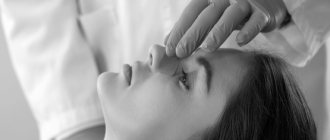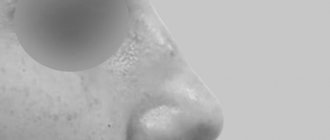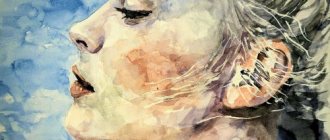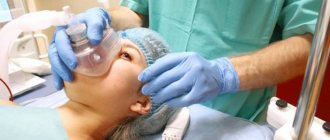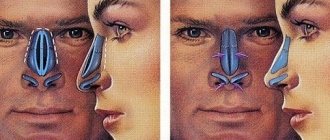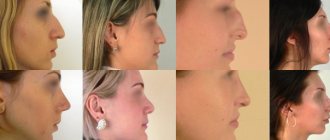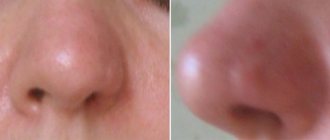Consultation with plastic surgeons with over 20 years of experience – free! Sign up by phone. Waiting for you!
Plastic surgery always strives for constant renewal and improvement. Today, more and more techniques and operations are appearing that are designed to achieve the best results with minimal “sacrifices.” These include plastic surgery of the tip of the nose.
, which, if certain requirements are met, allows you to achieve a good aesthetic effect. Let us consider the features and differences of this operation from rhinoplasty in full.
What is nasal tip rhinoplasty?
This is a surgical intervention during which the surgeon changes the location of the soft tissues and cartilage on the wings and tip of the nose. Cosmetic imperfections are eliminated using resection, transplantation, suturing, reposition and other surgical procedures. The procedure is performed in a hospital setting and in most cases under general anesthesia.
Rhinoplasty is one of the most difficult operations in aesthetic medicine, since the shape and structure of cartilage is individual for each patient. Surgical intervention requires pinpoint precision from the surgeon, otherwise the reconstruction will not produce results or will worsen the appearance.
Technique of the operation
I always perform rhinoplasty under general anesthesia! This is a full-fledged plastic surgery, despite the small location of surgical manipulations.
- The patient comes to the clinic on an empty stomach.
- We again discuss the important nuances of end plastic surgery.
- The anesthesiologist collects anamnesis and prepares the patient for the procedure.
- The duration of surgical correction can be from 1.5 to 2.5 hours.
⇒ INFORMATION: What absolutely should not be done after rhinoplasty
What awaits you after waking up
Patients are concerned about how they feel after waking up. Modern drugs for medicated sleep (anesthesia) are easily tolerated. In rare cases, nausea and chills are possible. After 3-4 hours, the first meal is prescribed.
Be prepared for swelling and temporary difficulty breathing through your nose. After this operation, the plaster splint is not used; the updated shape is fixed with special plasters.
The patient usually spends a day in the clinic and goes home for rehabilitation after nasal tip surgery.
Nasal tip surgery
Correction methods
Rhinoplasty is performed in open and closed ways. In the first case, the doctor makes an incision on the bridge between the nostrils (columella) and releases the pterygoid cartilages. After this, excess tissue is removed, and the tip of the nose is given the desired shape using sutures. If necessary, the bridge is raised and strengthened using supporting cartilages. The open method provides a complete overview of the surgical field, therefore providing more options and reducing the risk of errors and inaccuracies. The only disadvantage of this method is a small scar on the columella. If the operation is performed by an experienced surgeon, the scar will be barely noticeable and will practically disappear over time.
Closed rhinoplasty is performed from the inside of the nasal cavity through an incision in the mucous membrane. The doctor releases the pterygoid cartilage and applies sutures, which will subsequently correct the shape of the tip of the nose. The operation takes less time compared to open rhinoplasty, and the results can be seen faster. Another advantage of the technique is that the postoperative scar is hidden in the nasal cavity and is completely invisible. The disadvantages of the procedure include limited access to the operated area. Because of this, the surgeon cannot use all possible techniques that give the best result. Limited visibility makes it difficult to control the condition of blood vessels, so the likelihood of bleeding and hematomas increases.
The technique is chosen depending on the nature of the aesthetic defect and the characteristics of the patient’s anatomy. In difficult cases, the open method is often used.
Indications
The operation is carried out according to direct and indirect indications. In the first case, the procedure is used to correct serious congenital defects or anomalies that are caused by burns, frostbite and mechanical damage. Indirect indications mean the patient’s desire to improve his appearance, to make his facial features more proportional and attractive.
Surgery is indicated if the tip of the nose:
- too wide;
- forked;
- curved;
- upturned or down;
- deformed as a result of injury or surgery.
Computer modeling is used to predict results. Thanks to this technology, the patient can see how his face will change after surgery.
Causes of snub nose
Typically, a snub nose is a hereditary trait, often passed down from generation to generation. But acquired factors are also possible. These include:
- previous infectious diseases involving the skin of the nose and underlying tissues;
- nasal fractures;
- injuries of the facial skeleton;
- mechanical damage to the nose;
- unsuccessful rhinoplasty.
The final shape of the nose is formed by the age of 18; before this period, bone and cartilage tissues are still developing, soft tissues can grow. Therefore, any interventions and corrections regarding snub nose are carried out only after adulthood. Only rhinoplasty can provide a radical and lifelong effect; injection methods can temporarily correct the situation.
Contraindications
Any operation has contraindications if there are health problems. Plastic surgery is not performed if the patient has the following diseases and pathological conditions:
- oncology;
- diabetes mellitus;
- herpetic infection;
- severe pathologies of the heart, kidneys and liver;
- low blood clotting;
- hepatitis B and C.
There are also time restrictions for surgical intervention. These are inflammatory processes in the operated area, respiratory infections and exacerbations of chronic diseases. The operation is not performed on women during menstruation, pregnancy or breastfeeding.
Consultation and preparation for the procedure
At the initial consultation, I talk with the patient and listen to their wishes. I do a palpation examination of the condition of the osteochondral skeleton of the nose and assess the respiratory function. We select a date for changing the tip projection.
The default correction is performed on healthy people. To exclude possible diseases, the patient undergoes laboratory tests and consultation with specialists.
What tests need to be taken before the procedure?
- general and biochemical blood test;
- on RW, HIV;
- for hepatitis C and B;
- for prothrombin;
- ECG;
- X-ray of the paranasal sinuses;
- blood type and Rh factor.
MALE HARMONIZING RHINOSEPTOPlasty
Types of correction
There are many types of plastic surgery, depending on the physiological characteristics of the patient and the goals set. In particular, the wide tip is reduced by resection (excision of “extra” cartilage tissue) or in a more gentle way by suturing the pterygoid cartilages in the dome area. The problem of an upturned nose is solved by transplantation. To do this, the patient’s own cartilage tissue is used, which replenishes the volume in the problem area. In case of “bifurcation” of the columella, the right and left pterygoid cartilage in the area of the dome and medial crura are sutured.
The drooping tip is corrected using various techniques. For example, the lower fragment of the nasal septum and part of the pterygoid cartilage are excised, and then the remaining structures are brought together. An alternative method is tissue transplantation into the columella area. For transplantation, a miniature fragment of the auricle is usually taken.
The method of correction is determined by the surgeon after studying the patient’s problem. When choosing a technique, the doctor takes into account physiological characteristics: the general anatomy of the face, the density of cartilage tissue, the shape of the nostrils and nasal septum.
How is the operation performed?
Rhinoplasty of the tip of the nose is performed under general or local anesthesia. The method of pain relief is chosen depending on the type of operation. During general anesthesia, strong sedatives are administered intravenously or multicomponent endotracheal anesthesia is used. During the operation, the doctor makes incisions inside or outside the nose, separates the cartilage from the soft tissue, and removes excess muscle and bone structures using special instruments. At the final stage, the tip of the nose is formed and cosmetic sutures are applied using biodegradable material. The affected area is covered with a bandage and fixed with a plaster splint.
Rhinoplasty BEFORE and AFTER
All photos
Plastic and maxillofacial surgeon Ekaterina Sergeevna Kudinova - Candidate of Medical Sciences, senior researcher at the leading Moscow scientific and clinical center of otorhinolaryngology - has extensive experience in performing all types of operations on plastic and reconstructive surgery of the nose and midface.
Rhinoplasty of the nose in Moscow
Rehabilitation period
With proper preparation and adherence to the surgical technique, rehabilitation proceeds quickly and without complications. Patients may be bothered by minor swelling, hematomas and pain that go away on their own or after taking anti-inflammatory drugs. Sometimes mild swelling persists for 2–3 months, which is considered normal.
After the intervention, the patient must follow several rules:
- sleep on your back, leaning on a high pillow;
- protect the wound from contact with water for several days;
- for at least 3–4 weeks, avoid physical activity, visiting the sauna, bathhouse and solarium;
- stick to a diet, avoid spicy, salty and fatty foods.
Often, the doctor gives individual recommendations to consolidate the result and shorten the rehabilitation period. Changes in appearance can be assessed after 8–10 weeks, and the tip of the nose will take its final shape 6–12 months after surgery.
Preparation
Before undergoing rhinoplasty, it is recommended to avoid the use of medications and nasal drops for three months before surgery, as many of them can interfere with the healing process after surgery.
If they are still used, then it is necessary to notify the attending physician about this. You should also not take any medications without consulting your doctor. Some medications may interact unfavorably with drugs used for anesthesia and anesthesia. It is necessary to stop smoking for 4 weeks before and after rhinoplasty (in some cases for a longer period, as determined by the doctor).
Possible complications
Complications usually arise due to the surgeon’s unprofessionalism and violation of the preparatory and rehabilitation regime. The most common negative consequences are a rough scar at the incision site, wound infection, dry mucous membrane, loss or distortion of sensitivity in the operated area. For any complications, medical consultation is required. If necessary, the patient is prescribed additional therapy, and in severe cases, repeated surgery.
Mobility of the nose after rhinoplasty is normal. Within 12–18 months after the intervention, patients may experience spontaneous changes in the shape of the tip, which lowers, rises, or moves to the side. Experienced surgeons warn in advance about this problem and help solve it.
Rehabilitation
The duration of the recovery period after rhinoplasty is on average six months; throughout the entire period, swelling of the tissues of the nose and face as a whole slowly resolves. For the first 1-3 days after surgery, the patient is under inpatient observation by clinic specialists and then discharged home, but under strict supervision. The fixation bandage must continue to be worn for at least 2 weeks after surgery. Throughout the entire recovery period, it is recommended not to abuse smoking and alcohol, avoid visiting the solarium, baths and saunas, sunbathing, drinking hot drinks and food; reduce physical activity as much as possible. Do not physically impact the nose (do not knead, massage, do not wear glasses). And the most important thing is to maintain your immunity as much as possible in order to prevent colds and runny nose, in particular.
In just 2-3 months you will see the main results of nose shape correction. Over the next 9 months, the skin will “tighten” and the contours of the nose may change by 0.5-2 mm. That is, the results of aesthetic surgery are assessed after a year.
Cost of the procedure
The price depends on the complexity of the operation, technique, type of anesthesia, equipment and medications used. There are other factors that influence pricing. The cost of the procedure in the capital’s clinics is higher than in most Russian regions. The services of a qualified surgeon who knows the original technique will cost more than the average specialist. And the primary operation will cost less than correction of unsuccessful surgery.
conclusions
Rhinoplasty of the tip of the nose allows you to eliminate serious cosmetic imperfections and radically change your appearance. Thanks to the operation, patients solve aesthetic and psychological problems and gain confidence in their own attractiveness. However, in some cases the procedure is contraindicated for objective reasons or is useless because it will not give the desired results. Therefore, it is better to make the decision about surgery after consultation with an experienced surgeon. He will assess the feasibility of the intervention and, if necessary, recommend an alternative, for example, non-surgical rhinoplasty using threads or fillers.
